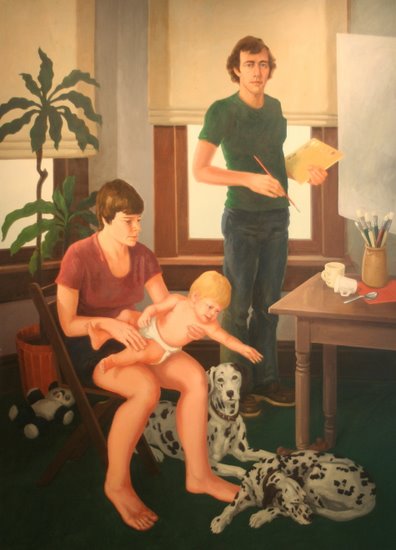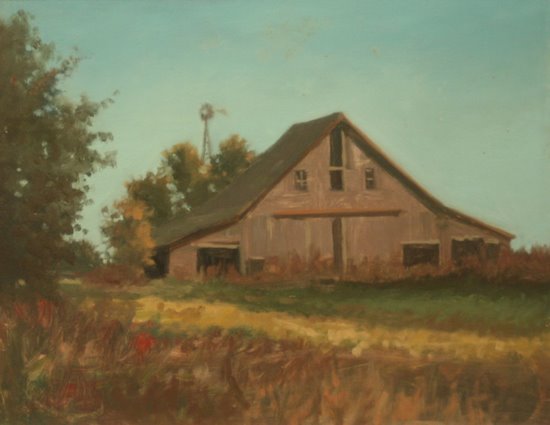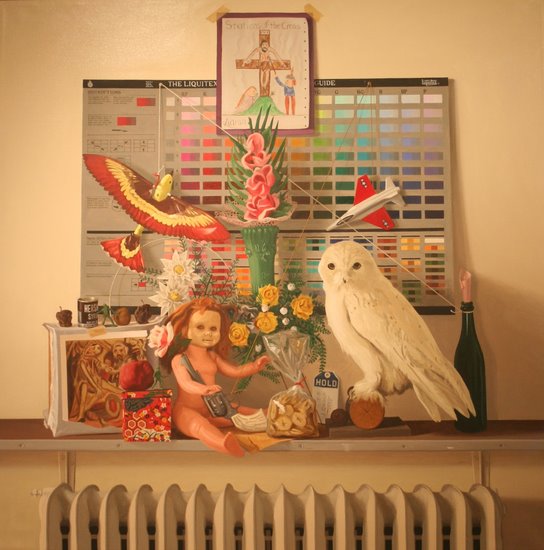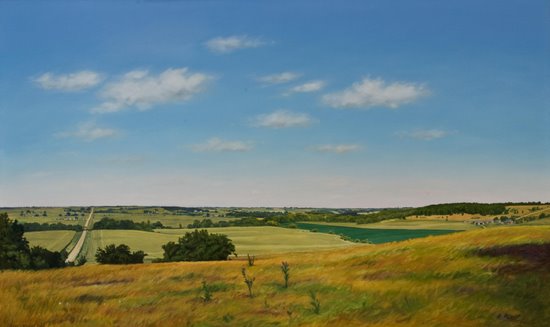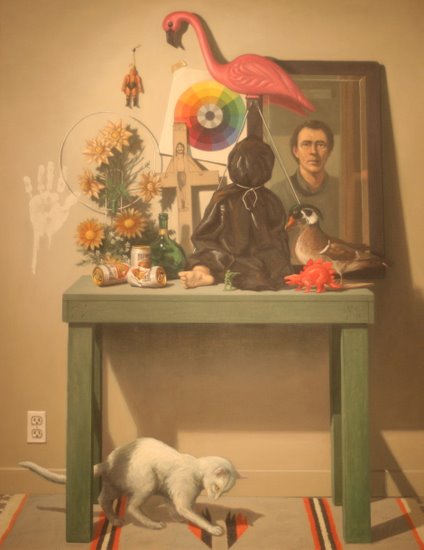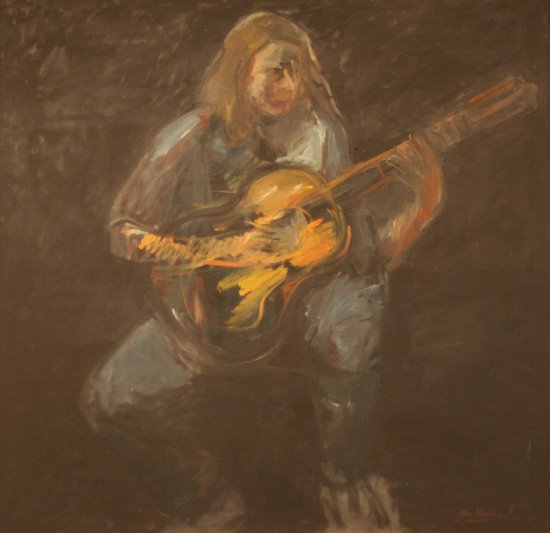There is no doubt that Jim Konrad was a brilliant technician.
"He knew more about the nature of artist materials than any other artist in the Quad Cities," said Sherry Maurer, director of the Augustana College Art Museum.
"He was very serious about technique," said his wife Cathy. "And they [his artworks] all have superb technique - color form, composition, things like that." She called him an "artist's artist."
Peter Xiao, a teaching colleague of Konrad's at Augustana for more than two decades, said the artist's work is "perfectly balanced" in terms of color - the dark and light, the chromatic scheme.
The Figge Art Museum, in its description of two Konrad works in its collection, notes his "meticulous craftsmanship and expertise in painting methods and materials."
And in an interview with Bruce Carter earlier this year for the WVIK program Art Talks, Konrad (whom I never met) called himself a teacher of fundamentals. "The more you understand about how to use your materials and how to do it, the more it frees you to be an artist," he said.
Konrad's technical acumen is plainly evident in the Augustana College Art Museum's current memorial exhibit, celebrating the artist and faculty member who died in May at age 67.
For just one admittedly minor illustration, look at how he painted masking tape in a number of pieces. As Maurer said, "Sometimes ... we've had big debates as to whether it's real tape or not."
But praising somebody's proficiency - even one as fine-tuned as Konrad's - can be a backhanded compliment. And the body of work on display at Augustana College shows an artist fluent in many forms of expression who explored the world in rich and sometimes discomforting ways.
The show, which opened this week and runs through September 17, features more than 50 works spanning the past four decades but focusing on his output from the 1980s and '90s. Konrad's family, Maurer, and Xiao selected the pieces, drawing almost exclusively from more than 200 works in the artist's home.
The gallery's top floor is highlighted by his landscapes, ideal vehicles for his mastery of color and light. "The luminosity in them is just wonderful," Maurer said. These scenes - sometimes pastoral, sometimes not - offer "the sense of everyday life that still has wonder in it," she said.
A pair of Davenport skylines, she said, are "super-realist kinds of renditions."
Yet it's more an illusion of realism, the impression of consistent detail where it doesn't really exist. It's "fascinating to see the kind of simplification that he found to be able to present all this visual information to us without completely overwhelming us," Maurer said. Konrad "painted with such clear, clean brush strokes. He just left things so convincing in terms of his articulation of those buildings." And then he brought them together by "getting a consistent light and a sense of color unity within the piece."
The art gallery's top floor also features early explorations in the styles of other artists, and a family portrait from 1976 whose myriad technical demands are lost in its seemingly effortless execution.
But it's on the lower floor of the art gallery - with its series of fraught still lifes - that Konrad's artistry beyond his use of methods and materials becomes abundantly clear.
Xiao marvels at Studio Wall: the trompe l'oeil details of its shelf and radiator, the precise rendering of a commercial-paint chart in the background, and how Konrad painted strings to guide, focus, and hold together. "Formally speaking, this is not something that many artists could accomplish," he said. "The large order of things, but also in small aspects - how the small aspects are technically challenging and then they add up to the total."
Yet resting against the shoulder of a doll is revolver - a hint at the implied violence in many of his still lifes.
In other still-life works, baby dolls are blindfolded or have plastic bags over their heads, strings tied around the necks. A ventriloquist's dummy is attached to a wall by its arms with electrical tape, and is also blindfolded. A toy wrestler is hanged, a thumbtack securing the noose. There's the repeated motif of a drawing of the crucified Christ - originally by Konrad's son Aaron - with his hands waist-level, as if his shoulders as well as his extremities had been nailed to the cross.
These grim objects are beautifully rendered, carefully organized and placed, and balanced by the whimsical and ephemeral. Survival of the Fittest features a pink-flamingo yard ornament, empty cans of Milwaukee's Best, and plastic soldiers and dinosaurs, and a cat appears to be scratching the carpet.
Yet rather than neutralize the paintings' darker elements, these objects serve to highlight them through contrast. And Konrad's realistic, matter-of-fact painting style lends them a tense ambiguity: What are we to make of these? As the Figge's notes state about this vein of work: "Konrad's cool detachment paradoxically manages to convey a subtle yet powerful message about patriotism, consumerism, and American ideologies."
Xiao said that Konrad found significance in these often mundane objects. "He took more time to look at them than many of us," he said. "And meaning or narrative would be there when you spend time dwelling on something."
"I think he would spend more time compiling the still lifes than actually painting them," Konrad's son Jeff said.
Both he and Cathy Konrad said these works are open. "I think he did leave stuff up for interpretation," Jeff said. "He didn't really defend every tiny object in a painting," Cathy added.
But the people to whom I talked were uniform in reading these still lifes as dealing generally with the horrors of war. Konrad served as a U.S. Navy medic in Vietnam, and the mark it left on him is plain in one piece from his Vietnam series that hangs on the upper level. It's been paired with a painting of a dead bird - another staple of his work.
The lower-level still lifes - produced between 1984 and 2000 - aren't nearly so blunt, instead quietly provoking.
"If you got to know Jim better, I think you saw the empathy that he had for the rest of the world, which translates somewhat into an anguish about war, about unfair violence, injustice ... ," Maurer said.
And Jeff Konrad noted that the still lifes are, in their way, gentle. "If you think about how those dolls are treated in the paintings, those are how human beings are treated in real life in war," he said. "The bag over the head, that's straight out of Abu Ghraib. It's almost prophetic ... . As disturbing as they are, they're not nearly as disturbing as the dialogue he was trying to create ... as a reflection of what goes on ... ."
Jeff also said that while his father's work was largely done in a realistic style, that was a tool rather than the point: "He's not so much a realist, because what he's getting across is the content, the statements that are in it. While it may be depicted realistically in many of the paintings, that's not really the foremost concern."
Xiao wrote in appreciation: "He was realist, formalist, and expressionist rolled into one, our Van Gogh, Cézanne, and Corot."
"I like realism," Konrad said on Art Talks. "I like to look at a picture."
While the still lifes display a clinical exactness - they almost feel too distant emotionally, and a touch dry - there's passion elsewhere. A series of small pieces depicting pregnant women on fire - inspired by war atrocities against Bosnian women - has an aggressively loose style obviously fueled by outrage. A portrait of Jeff Konrad playing a guitar also departs from the realism that characterizes most of the work in the show.
While there are two dominant strains in the show - the peacefully still landscapes, and the distressingly still still lifes - Cathy Konrad said her husband worked with a single goal. "His purpose of art was to evoke an emotion," she said.
And she added that he was truthful to experience, whether it was his upbringing in rural Iowa or being part of a war: "He painted what he knew, painted what he felt, painted what he loved, and painted things about situations that were crazy."
A Memorial Tribute to Jim Konrad runs through September 17 at the Augustana College Art Museum, located in Centennial Hall (Seventh Avenue and 38th Street in Rock Island). Public hours are noon to 4 p.m. Tuesday through Saturday.
A tribute evening for Jim Konrad and his art will be held on Thursday, September 15, at 7:30 p.m. in Larson Hall. The event concludes with a reception in the exhibit gallery. Admission is free.

